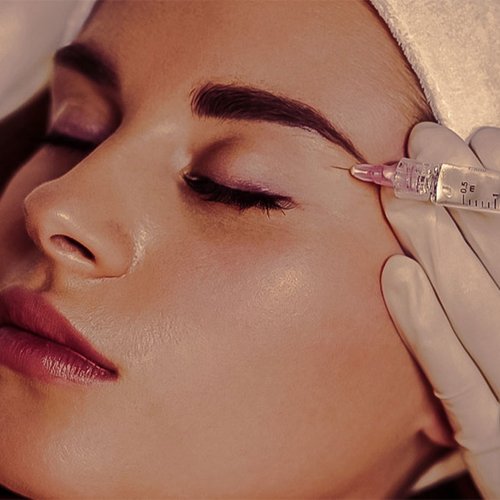Hair Transplant
Restore your confidence with our advanced hair transplant solutions.


CM-24, 2nd Floor DPS School,
Noida

SJM Hospital, Chhijarsi, Sector 63,
Noida, Uttar Pradesh 201307
Acne marks, also known as post-inflammatory hyperpigmentation (PIH), are the result of inflammation and damage to the skin caused by acne lesions. When the skin experiences trauma, such as acne breakouts, the body responds by producing excess melanin, the pigment responsible for skin color. This excess melanin can accumulate in the affected area, leading to the appearance of dark spots or patches known as acne marks.
There are several factors that contribute to the development of
acne marks:
Inflammation: Acne is primarily an inflammatory skin
condition. When the skin becomes inflamed due to the presence of
acne-causing bacteria, excess oil production, or clogged pores, it
triggers the body's natural defense mechanism. In response to
inflammation, the skin produces melanin as a protective measure,
which can lead to hyperpigmentation and the formation of acne
marks.
Skin Type: Individuals with darker skin tones are more prone to developing acne marks due to their increased production of melanin. This means that even minor skin trauma, such as a pimple or acne breakout, can result in noticeable hyperpigmentation.
Severity of Acne: The severity and duration of acne breakouts can also influence the likelihood of developing acne marks. Severe acne lesions, such as cysts or nodules, are more likely to cause significant inflammation and damage to the skin, leading to more pronounced hyperpigmentation.
Picking or Popping Pimples: One of the most common causes of acne marks is the habit of picking, squeezing, or popping pimples. This can further traumatize the skin and exacerbate inflammation, leading to increased melanin production and the formation of dark spots.
Sun Exposure: Sun exposure can worsen existing acne marks by stimulating melanin production and causing further darkening of the affected areas. UV radiation from the sun can also prolong the healing process and make acne marks more resistant to treatment.
Hormonal Changes: Hormonal fluctuations, such as those that occur during puberty, menstruation, pregnancy, or menopause, can influence oil production and increase the likelihood of acne breakouts. These hormonal changes can also affect melanin production, making individuals more susceptible to developing acne marks.
Overall, the development of acne marks is a complex process influenced by various factors, including inflammation, skin type, acne severity, habits like picking or popping pimples, sun exposure, and hormonal changes. Preventing acne marks involves proper acne management, avoiding skin trauma, protecting the skin from sun damage, and seeking professional treatment when necessary.

Radiant skin awaits with SkinPlasty's transformative formulas. Glow from within with our curated skincare solutions.
Restore your confidence with our advanced hair transplant solutions.
Say goodbye to acne and scars with our expert treatments.
Revitalize your skin and hair with PRP therapy.
Unveil radiant, youthful skin with our chemical peeling treatments.
"Noida's premier service provider! Exceptional quality, unbeatable prices, and unparalleled customer satisfaction. Experience the best with us today!"
Expert skin care from certified professionals. Comprehensive services for healthy smiles. Experienced, caring skin specialist.
Cutting-edge treatments using the latest Skin technologies. Advanced equipment for precise diagnosis and comfortable procedures. Stay ahead with us.
Dedicated healthcare professionals committed to your well-being. Expertise, compassion, and quality care for optimal health outcomes.

A skilled team of doctors dedicated to your health. Experience, expertise, and compassion for comprehensive care and positive outcomes.
Quality skin care at affordable prices. Accessible treatments for a healthy smile without breaking the bank. Your oral health matters.
Round-the-clock customer support for all your Skin needs. Assistance anytime, anywhere, ensuring your peace of mind. We're here for you.
Acne is a common skin condition that affects millions of people worldwide, regardless of age, gender, or ethnicity. It occurs when hair follicles become clogged with oil and dead skin cells, leading to the formation of pimples, blackheads, and whiteheads. While acne itself can be frustrating and uncomfortable, one of the most significant concerns for many individuals is the potential for scarring or marks left behind after the acne has healed.
Not all acne will leave marks, but certain factors increase the
likelihood of scarring:
Severity of Acne: The more severe the acne, the greater the
likelihood of scarring. Severe forms of acne, such as cystic acne,
are more likely to cause scarring than mild or moderate acne.
Picking and Squeezing: Picking or squeezing acne lesions can increase inflammation and damage the surrounding skin tissue, leading to a higher risk of scarring. It's essential to resist the urge to pick at acne, as this can worsen the condition and prolong healing time.
Delayed Treatment: Prompt and effective treatment of acne can help minimize the risk of scarring. Delayed treatment may allow acne lesions to become more inflamed and deeper, increasing the likelihood of scarring.
Skin Type: Individuals with certain skin types, such as those with naturally oily or sensitive skin, may be more prone to developing acne scars. Additionally, individuals with a family history of acne scarring may have a genetic predisposition to scar formation.
Types of Acne Marks:
Post-inflammatory Hyperpigmentation (PIH): PIH occurs when the
skin produces excess melanin in response to inflammation. This can
result in dark spots or patches that linger after acne lesions have
healed. PIH is more common in individuals with darker skin tones.
Post-inflammatory Erythema (PIE): PIE refers to red or purplish marks left behind after acne inflammation has resolved. These marks are caused by dilated blood vessels and typically fade over time but may persist for several months.
Atrophic Scars: Atrophic scars result from a loss of collagen and tissue beneath the skin's surface. These scars may appear as shallow depressions or pits and are more common in severe cases of acne.
Hypertrophic Scars: Hypertrophic scars are raised, thickened areas of skin that develop when the body produces too much collagen during the healing process. These scars are less common in acne but can occur, particularly in individuals prone to keloid formation.
Preventing Acne Marks:
Early Treatment: Seek treatment for acne as soon as it develops
to prevent inflammation and reduce the risk of scarring.
Gentle Skincare: Use gentle skincare products and avoid harsh
scrubbing or abrasive treatments that can irritate the skin and
exacerbate acne.
Sun Protection: Protect your skin from the sun's harmful UV
rays by wearing sunscreen daily. Sun exposure can worsen acne marks
and delay the healing process.
Avoid Picking: Resist the temptation to pick, squeeze, or pop
acne lesions, as this can lead to scarring and further inflammation.
while not all acne will leave marks, certain factors increase the risk
of scarring. By understanding these factors and taking proactive steps
to prevent and treat acne, individuals can minimize the likelihood of
developing long-lasting marks or scars and achieve clearer, healthier
skin.

Discover leading skin specialists in Noida offering advanced dermatological solutions. From acne to aging, trust their expertise for radiant, healthy skin.

Years of experience

Satisfied Patients

Best Treatment

Expert Doctor